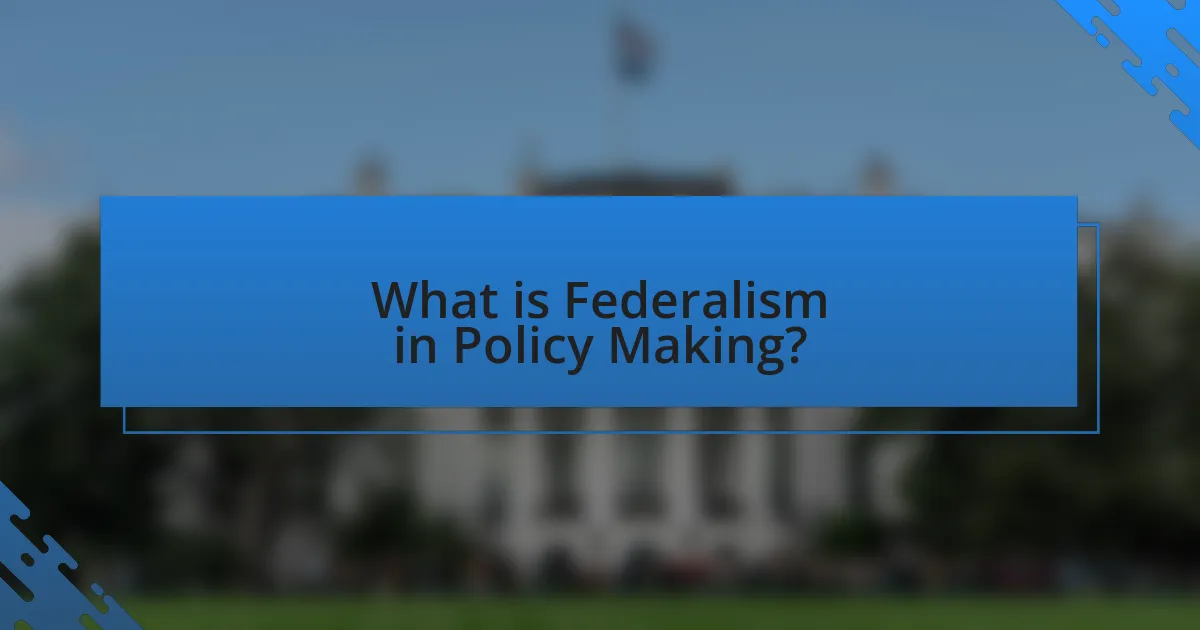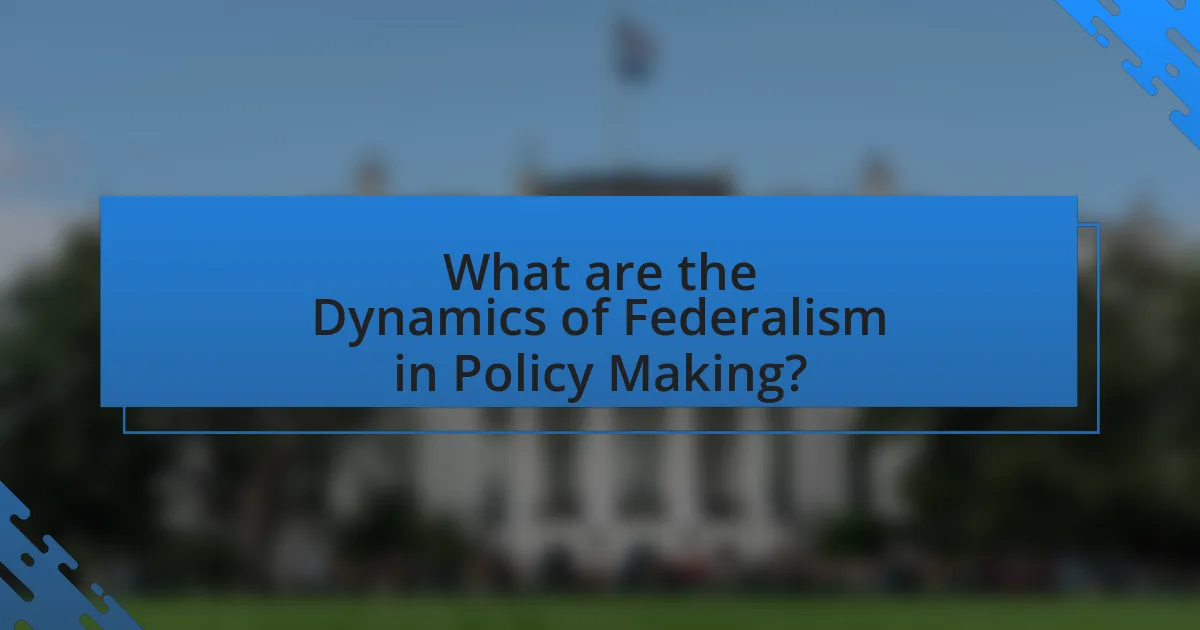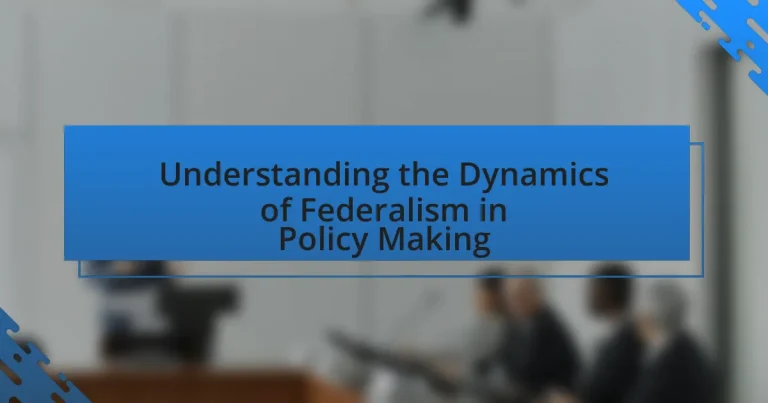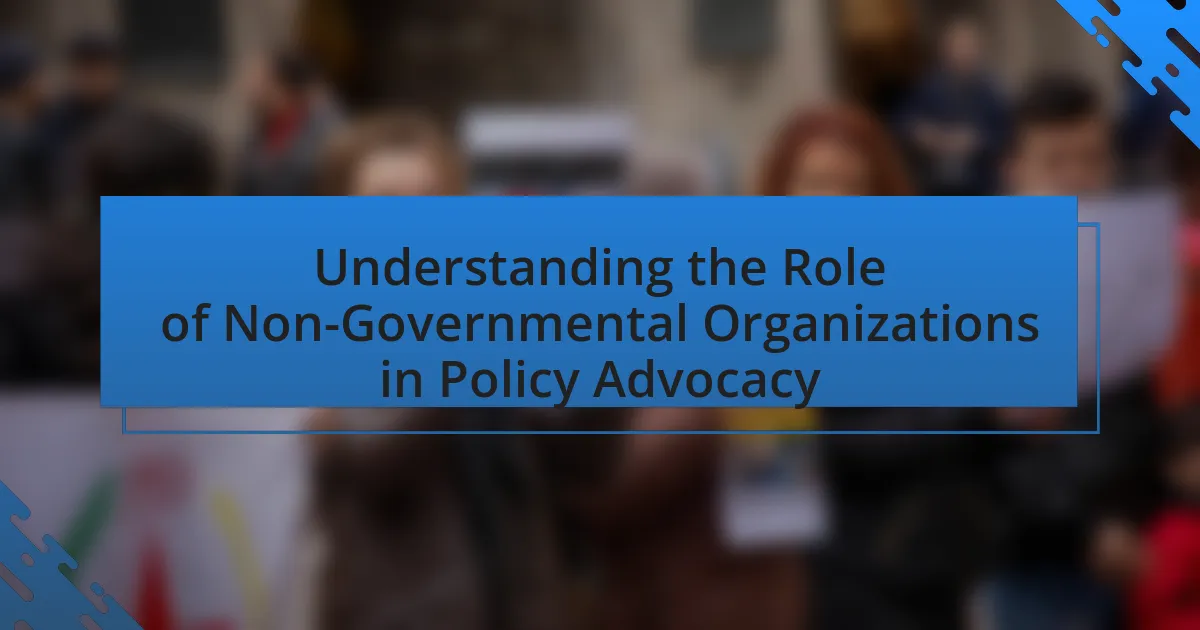Federalism in policy making is a governance system that divides power between central and regional governments, allowing for tailored policy implementation that reflects local needs. This article explores how federalism influences the policy-making process, highlighting key principles such as the division of powers, state sovereignty, and the supremacy of federal law. It examines the interaction between different government levels, the challenges and benefits of federalism, and its impact on specific policy areas like healthcare and education. Additionally, the article discusses how political, economic, and social factors shape federalism, the role of political parties, and strategies states use to adapt federal policies to local contexts.

What is Federalism in Policy Making?
Federalism in policy making is a system of governance where power and authority are divided between a central government and regional or state governments. This division allows for multiple levels of government to create and implement policies, reflecting the diverse needs and preferences of different regions. For example, in the United States, both federal and state governments have the authority to legislate on various issues, such as education and healthcare, leading to a dynamic interplay of policies that can vary significantly from one state to another. This structure promotes local autonomy while maintaining a unified national framework, enabling tailored solutions to regional challenges.
How does federalism influence the policy-making process?
Federalism influences the policy-making process by distributing authority between national and state governments, which creates a multi-layered governance structure. This division allows for diverse policy experimentation, as states can implement and test different approaches to issues like healthcare and education, leading to innovation and tailored solutions that reflect local needs. For example, the Affordable Care Act allowed states to expand Medicaid differently, resulting in varied outcomes that informed national discussions on healthcare reform. Additionally, federalism can lead to conflicts and competition between state and federal policies, as seen in areas like environmental regulation, where states may pursue stricter standards than federal guidelines. This dynamic interplay shapes the overall effectiveness and responsiveness of policy-making in a federal system.
What are the key principles of federalism that affect policy making?
The key principles of federalism that affect policy making include the division of powers, the supremacy of federal law, and the principle of state sovereignty. The division of powers allocates specific responsibilities to federal and state governments, influencing how policies are developed and implemented at different levels. The supremacy of federal law ensures that federal legislation takes precedence over state laws, which can shape policy outcomes by limiting state authority. Lastly, the principle of state sovereignty allows states to exercise their own powers and make independent policy decisions, leading to a diverse range of policies across the nation. These principles collectively create a complex framework that governs how policies are formulated and executed in a federal system.
How do different levels of government interact in a federal system?
In a federal system, different levels of government interact through a division of powers, where authority is shared between national and subnational entities. This interaction occurs via mechanisms such as legislation, funding, and administrative collaboration, allowing for both cooperation and conflict. For example, the U.S. Constitution delineates specific powers to the federal government while reserving others for state governments, creating a framework for negotiation and policy implementation. Additionally, federal grants often incentivize states to adopt certain policies, demonstrating how financial resources can facilitate intergovernmental cooperation.
Why is understanding federalism important for effective governance?
Understanding federalism is crucial for effective governance because it delineates the distribution of power between national and subnational governments, enabling tailored policy responses to diverse regional needs. This structure allows for local governments to address specific issues more effectively, as seen in countries like Canada and Germany, where regional governments implement policies that reflect local priorities and conditions. Furthermore, federalism promotes accountability and citizen participation by bringing governance closer to the people, which can enhance democratic engagement and responsiveness. Historical examples, such as the U.S. federal system, illustrate how federalism can foster innovation in policy-making through competition among states, leading to improved public services and governance outcomes.
What challenges does federalism present in policy implementation?
Federalism presents several challenges in policy implementation, primarily due to the division of powers between national and state governments. This division can lead to inconsistencies in policy application, as states may interpret and enforce federal laws differently, resulting in a patchwork of regulations. For instance, the implementation of healthcare policies under the Affordable Care Act varied significantly across states, with some opting for Medicaid expansion while others did not, creating disparities in access to healthcare services. Additionally, federalism can complicate coordination among various levels of government, making it difficult to achieve cohesive policy goals. This lack of coordination can hinder timely responses to issues such as natural disasters or public health crises, where a unified approach is often necessary for effective management.
How can federalism enhance democratic participation in policy making?
Federalism enhances democratic participation in policy making by decentralizing power, allowing local governments to address specific community needs more effectively. This structure encourages citizen engagement at multiple levels of government, as individuals can influence policies that directly affect their lives. For instance, in the United States, state and local governments have the authority to enact laws and regulations tailored to their populations, fostering a sense of ownership and accountability among citizens. Research indicates that regions with strong federal systems, such as Switzerland and Canada, exhibit higher levels of political participation and voter turnout, demonstrating that federalism can lead to more responsive governance and increased civic involvement.

What are the Dynamics of Federalism in Policy Making?
The dynamics of federalism in policy making involve the interaction between national and subnational governments, which influences the formulation and implementation of policies. This interaction is characterized by a division of powers, where both levels of government have distinct responsibilities, leading to a complex relationship that can enhance or hinder policy effectiveness. For instance, in the United States, the federal government sets broad policy frameworks, while state governments tailor these policies to local needs, exemplified by variations in healthcare and education policies across states. This duality can foster innovation through state-level experimentation but may also result in inconsistencies and conflicts, as seen in differing state responses to federal mandates. The balance of power and cooperation between these levels is crucial for effective governance and policy outcomes.
How do political, economic, and social factors shape federalism?
Political, economic, and social factors significantly shape federalism by influencing the distribution of power and responsibilities between national and subnational governments. Political factors, such as the ideological beliefs of political leaders and parties, determine how authority is allocated; for instance, a centralist government may favor a stronger national role, while a federalist government may promote state autonomy. Economic factors, including the level of economic development and resource distribution, affect federalism by dictating the financial capabilities of different government levels, which can lead to disparities in service provision and policy implementation. Social factors, such as cultural diversity and public opinion, also play a crucial role; regions with distinct identities may demand greater autonomy, thereby reshaping the federal structure to accommodate local needs and preferences. Historical examples, such as the evolution of federalism in the United States, illustrate how these factors interact to create a dynamic and often contentious relationship between different levels of government.
What role do political parties play in federal policy dynamics?
Political parties play a crucial role in federal policy dynamics by shaping legislative agendas, influencing public opinion, and facilitating governance. They act as the primary vehicles for political organization, enabling the mobilization of voters and the articulation of policy preferences. For instance, the Democratic and Republican parties in the United States have distinct platforms that guide their legislative priorities, impacting the types of policies that are proposed and enacted. Historical evidence shows that during periods of unified government, where one party controls both the executive and legislative branches, significant policy changes occur, such as the Affordable Care Act under President Obama in 2010. This illustrates how political parties can drive substantial shifts in federal policy through their control of government institutions and their ability to rally support for specific initiatives.
How do economic disparities influence federal policy decisions?
Economic disparities significantly influence federal policy decisions by shaping the priorities and resource allocations of government initiatives. Policymakers often respond to the needs of economically disadvantaged populations to address issues such as poverty, education, and healthcare access. For instance, the introduction of the Earned Income Tax Credit (EITC) in the 1970s aimed to alleviate poverty among low-income workers, demonstrating how economic inequality can drive legislative action. Additionally, federal funding for programs like Medicaid is often adjusted based on the economic conditions of states, reflecting how disparities can dictate the level of support provided to different regions.
What are the implications of federalism on public policy outcomes?
Federalism significantly influences public policy outcomes by allowing multiple levels of government to create and implement policies, which can lead to variations in policy effectiveness and accessibility. This decentralized structure enables states or regions to tailor policies to their specific needs, resulting in diverse approaches to issues such as healthcare, education, and environmental regulation. For instance, the Affordable Care Act’s implementation varied by state, leading to different levels of healthcare access and quality across the country. Additionally, federalism can create competition among states, prompting them to innovate and improve policies to attract residents and businesses, as seen in tax policies and business regulations. However, it can also lead to inconsistencies and conflicts between state and federal laws, complicating governance and policy enforcement.
How does federalism affect the distribution of resources in policy making?
Federalism significantly influences the distribution of resources in policy making by allocating authority and responsibilities between national and subnational governments. This division allows states or provinces to tailor policies and resource allocation to their specific needs, leading to variations in public services and funding levels across regions. For instance, in the United States, federalism enables states to receive federal grants for education, healthcare, and infrastructure, which they can distribute according to local priorities. This decentralized approach can result in disparities in resource availability, as wealthier states may have more capacity to leverage federal funds effectively compared to poorer states. Consequently, federalism shapes not only the quantity but also the quality of resources allocated to different policy areas, reflecting the diverse needs and priorities of various regions.
What are the effects of federalism on policy innovation and experimentation?
Federalism enhances policy innovation and experimentation by allowing states to serve as laboratories for democracy. This decentralized structure enables individual states to implement diverse policies tailored to their unique needs and contexts, fostering competition and learning among them. For instance, states like Massachusetts and California have pioneered healthcare reforms and environmental regulations, respectively, which can be evaluated for effectiveness before potential adoption at the federal level. Research by the National Bureau of Economic Research indicates that states with greater autonomy are more likely to innovate in areas such as education and public health, demonstrating that federalism can lead to a more dynamic policy landscape.

How does Federalism Impact Specific Policy Areas?
Federalism impacts specific policy areas by distributing authority between national and state governments, leading to variations in policy implementation and outcomes. For instance, in healthcare, states can adopt different Medicaid expansion strategies under the Affordable Care Act, resulting in diverse access to services and coverage levels across the country. This decentralized approach allows states to tailor policies to their populations’ needs, but it can also create disparities in service quality and availability, as evidenced by the fact that as of 2021, 12 states had not expanded Medicaid, leaving millions without coverage options.
What are the key policy areas influenced by federalism?
Key policy areas influenced by federalism include education, healthcare, transportation, and environmental regulation. Federalism allows both national and state governments to create policies in these areas, leading to variations in implementation and standards across the country. For instance, education policy is shaped by both federal mandates, such as the Every Student Succeeds Act, and state-level decisions regarding curriculum and funding. In healthcare, the Affordable Care Act exemplifies federal influence while states manage Medicaid programs. Transportation policies, including infrastructure funding, are often a collaboration between federal and state governments, reflecting local needs. Environmental regulations also demonstrate federalism, as states can enact stricter laws than federal standards, as seen in California’s emissions regulations.
How does federalism shape healthcare policy in the United States?
Federalism shapes healthcare policy in the United States by distributing authority between federal and state governments, leading to varied healthcare regulations and programs across the country. This division allows states to tailor healthcare policies to their specific populations, resulting in differences in Medicaid expansion, public health initiatives, and insurance regulations. For instance, the Affordable Care Act enabled states to decide whether to expand Medicaid, resulting in 38 states and the District of Columbia opting for expansion while 12 states did not, demonstrating the impact of state-level decision-making on healthcare access.
What is the impact of federalism on education policy across states?
Federalism significantly impacts education policy across states by allowing individual states to tailor their educational systems to meet local needs and preferences. This decentralized approach leads to variations in curriculum standards, funding mechanisms, and educational outcomes, as states exercise their authority to implement policies that reflect their unique demographics and priorities. For instance, according to the National Center for Education Statistics, states like Massachusetts and California have developed distinct educational frameworks that cater to their specific populations, resulting in differing levels of student performance and resource allocation. Thus, federalism fosters diversity in education policy, enabling states to innovate and adapt while also creating disparities in educational quality and access.
How do states respond to federal policies under a federal system?
States respond to federal policies under a federal system by either implementing, resisting, or adapting those policies based on their own interests and political contexts. For instance, states may choose to implement federal policies that align with their goals, such as adopting federal education standards to receive funding. Conversely, states may resist federal mandates, as seen in cases like the legalization of marijuana, where several states have opted to disregard federal law. Additionally, states often adapt federal policies to better fit local needs, such as modifying healthcare programs to address specific demographic challenges. This dynamic interaction illustrates the complex relationship between state and federal governments, where states exercise their authority to shape the application of federal policies in ways that reflect their unique circumstances and priorities.
What strategies do states use to adapt federal policies to local needs?
States employ several strategies to adapt federal policies to local needs, including legislative adjustments, administrative discretion, and stakeholder engagement. Legislative adjustments allow states to modify or create laws that align federal mandates with local priorities, ensuring relevance to their specific contexts. Administrative discretion enables state agencies to interpret and implement federal guidelines in ways that address local circumstances, often leading to tailored solutions. Additionally, stakeholder engagement involves collaborating with local communities, businesses, and organizations to gather input and foster support, which can influence how federal policies are executed at the state level. These strategies collectively enhance the effectiveness of federal policies by ensuring they are responsive to the unique challenges and opportunities present in different states.
How do state-level innovations influence federal policy changes?
State-level innovations significantly influence federal policy changes by serving as experimental grounds for new ideas and practices that can be adopted at the national level. For instance, states like Massachusetts and California have pioneered healthcare reforms and environmental regulations, respectively, which have prompted federal discussions and eventual policy adaptations, such as the Affordable Care Act. Research indicates that successful state policies often create a model for federal legislation, as seen in the way state-level initiatives on renewable energy have led to federal incentives for clean energy development. This dynamic illustrates how state-level experimentation can shape the broader federal policy landscape, driving national reforms based on localized successes.
What best practices can enhance the effectiveness of federalism in policy making?
Best practices that can enhance the effectiveness of federalism in policy making include fostering intergovernmental collaboration, ensuring clear delineation of powers, and promoting citizen engagement. Intergovernmental collaboration allows for the sharing of resources and expertise, which can lead to more effective policy outcomes. For instance, the U.S. federal system has seen successful initiatives like the Clean Air Act, where state and federal governments worked together to improve air quality. Clear delineation of powers helps prevent conflicts and overlaps, ensuring that each level of government can operate effectively within its jurisdiction. Additionally, promoting citizen engagement through public consultations and participatory governance can lead to policies that better reflect the needs and preferences of the populace, as evidenced by various state-level initiatives that have incorporated public feedback into legislative processes.





